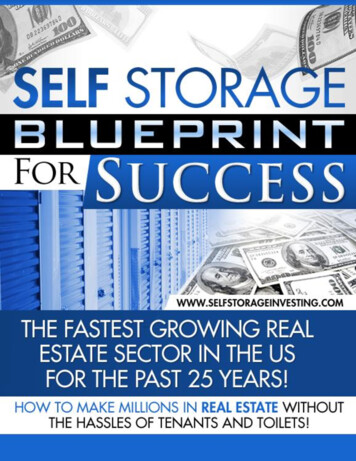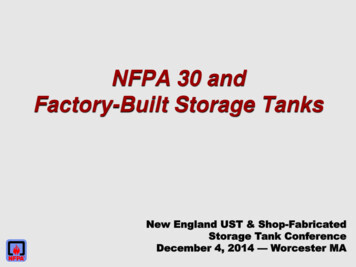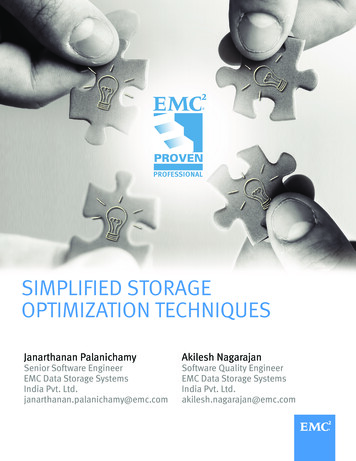
Transcription
Self Storage Blueprint for SuccessCopyright 2016 – Scott Meyers - All Rights Reserved Worldwide.www.selfstorageinvesting.com1
Self Storage Blueprint for Successwww.selfstorageinvesting.comWARNING: This eBook is for your personal use only.You may NOT Give Away, Share Or Resell ThisIntellectual Property In Any WayAll Rights ReservedCopyright 2016 – Scott Meyers. All rights are reserved. You may not distributethis report in any way. You may not sell it, or reprint any part of it without writtenconsent from the author, except for the inclusion of brief quotations in areview.DisclaimerWritten By Scott MeyersNo part of this book may be reproduced in any form nor used for teaching purposes withoutthe express written permission of the Author.This publication is designed to provide accurate information with regard to the subject mattercovered. It is sold with the understanding that the publisher is not engaged in rendering legal,accounting, or other professional advice. If legal advice or other expert assistance is required, theservices of a competent professional person should be sought.Copyright 2016 – Scott Meyers - All Rights Reserved Worldwide.2
Self Storage Blueprint for Successwww.selfstorageinvesting.comTABLE OF CONTENTSIntroduction – The Top 10 Reasons Why Self Storage is the Hottest Sector in Commercial RealEstateCHAPTER 1: Industry Overview Definition of Self StorageThe History of Self StorageSelf Storage Tenants (Clients)The Current State of the MarketCHAPTER 2: Investment Opportunities In self storage 20 Reasons to invest in Self Storage Now!Debunking the MythsCHAPTER 3: The Future of Self Storage Reasons for Increased DemandAdvancements in TechnologyMore Products & ServicesFocus on Customer ServiceIndustry ConsolidationIncreased CompetitionIncreased ValuesCHAPTER 4: To Buy or to BuildThe advantages of BuyingThe advantages of BuildingChapter 5: Case Study - Brownsburg Crossing Loan ProposalBusiness PlanAbout The AuthorGlossary of TermsCopyright 2016 – Scott Meyers - All Rights Reserved Worldwide.3
Self Storage Blueprint for Successwww.selfstorageinvesting.comIntroductionThe Top 10 Reasons why Self Storage is the Hottest sector in Commercial Real Estate.As you will read in my home study course, “The Complete Guide to Finding, Evaluating, andPurchasing Self Storage Facilities”, (www.SelfStorageInvesgting.com/homestudy), I began mycareer by building a large portfolio of single family and multi-family properties. I spent the first 10 yearsin real estate investment fighting with tenants and toilets and it almost drove me into the insane asylumand the bankruptcy court! Chasing tenants that wouldn’t pay, trying to stay ahead of rising taxes,insurance, and utility bills, and the ongoing, unexpected maintenance calls, almost forced me out of thebusiness. So I began to ask myself, what area of real estate could I invest in that could utilize the talentsand experience I have gained, without all the hassles of tenants and toilets? Well, after weighing alloptions, and after speaking with many of my mentors in the industry, I ultimately chose Self Storage asthe area I wanted to pour my efforts into and secure my future.So after 11 years of amassing a large portfolio of single family and multi-family apartmentcomplexes, I began to sell them all off, and begin investing in self storage facilities. And as most peoplesay once they have found their true calling, I wish I would have done it sooner! The self-storagebusiness isn’t without its fair share of challenges however and I certainly wouldn’t call it easy. But mylife has changed dramatically the day I sold my last apartment complex with all those tenants and toiletsand traded them for self-storage units filled with nothing but . STUFF!Now, I will share with you the top 10 reasons why I decided to sell all my houses and apartments toinvest in ONLY self storage:10. Endless Opportunities – If you already own a plot of land in a GOOD location, you can build.Now I don’t want to oversimplify the process because there are a great deal of zoning andApproval hurdles you may have to jump over, but this is a real estate business that is mucheasier to get into compared to most others. Also, contrary to popular belief, the large, publicoperators in the industry only account for about 12% of the estimated 64,000 facilities in thiscountry worth 22 Billion in 2007. That means there is a huge opportunity to pursueroughly 56,000 facilities that are owned by “mom and pop” investors that are alreadyestablished and cash flowing, and were developed specifically to sell off to investors once theywere stabilized!9. Sky Rocketing Demand for Storage – We have an insatiable appetite for storage in thiscountry, with over 2,000,000 units having been added since 2000. But probably the mostCopyright 2016 – Scott Meyers - All Rights Reserved Worldwide.4
Self Storage Blueprint for Successwww.selfstorageinvesting.comexciting prospect for the industry is the aging of the baby boomers. There are roughly 77million baby boomers in this country as of 2009, and they account for approximately 2 trillionin spending power. A recent poll by the Self Storage Association of a sampling of Baby Boomersrevealed that upon retirement, 50% planned to travel, 40% planned to move, and 10%planned to start a new job. What do people do when they move? That’s right, they store stuff.Downsizing, buying a second home, or even a like swap in houses necessitates a need forstorage. One economist recently compared the opportunity in this industry tositting on the oil industry in the 1950’s or sitting on Silicon Valley in the 1990’s!8. Multiple ways to increase Value and Profit Centers – I have had a great deal of success increating value with properties once I acquired them, but found the opportunities greater withself storage. There’s only so much you can do to a house, or with apartments that truly addsvalue, or commands a higher rent. But with Self Storage, you can take a vanilla facility andcreate multiple additional income streams such as:a. Retail centers that sell locks, boxes, moving suppliesb. A Truck Rental service through a 3rd party, or in-housec. A business center that charges for computer usage, copies, and faxd. Ebay Add-it centers where customers can pay you to sell their “stuff”e. A pack and ship business, and approximately 30 more profit centers that wehave indentify, and continues to grow.These additional services can contribute as much as 10-15% of the total income a facility bringsin on a monthly basis.7. LOW, LOW, Operating Costs – With my apartments, I was responsible for paying theutility costs for many of the common areas and vacant units, and in some properties, the gas andwater was on 1 meter, and was included in the rent. I was forced to pay for my tenants’wasteful use of gas and water. When the cost and/or taxes on these utilities increased, guesswho paid for it; ME! You simply can’t pass those increases along to the tenants without themgoing down the street to a competing property. With Self Storage, however, the expenses areminimal to begin with. You will pay for lights in the parking lot, and utilities for the office, butthose can be monitored, and increases can be easily absorbed. This makes budgeting forutilities and other variable costs a breeze compared to properties with tenants andtoilets. As a result, self-storage operating costs are typically much less than office, retail, andapartment buildings, which lowers the overall break-even occupancy.Copyright 2016 – Scott Meyers - All Rights Reserved Worldwide.5
Self Storage Blueprint for Successwww.selfstorageinvesting.com6. Low Rent and Collection Losses – 48 of the 50 states have a lien law with regard to selfstorage collections procedures, and the other 3 provide for steps that an owner can take tocollect past due rent. Each state’s law differs slightly, but most give the self-storage facilityowner the ability to perform the following steps when a tenant’s rent is past due:a. Remove the tenant’s gate code from the system, locking them out of boththe facility and their unit.b. Place another lock on the unit to keep them from entering it. This is whatwe call over locking the unit.c. Auction their goods if payment has not been received, typically within 90days after they were given notice.Each state requires that the tenant be given notice that they are past due, and most requireproof that notices were sent by certified mail or some other traceable format. Each state alsospecifies specific timing for each one of these actions, and also requires that proper notice isgiven to the tenant, and to the public by way of the local newspaper that their unit is beingauctioned off. The laws also specify what an owner can and can’t do with regard to the tenantsbelongs, and most require that the entire unit is auctioned off as a whole to avoid any liability.Either way, this far better than a landlord’s recourse when going through the legal process ofevicting and collecting back rent from tenants in the single family and multi-family apartmentworld.5. HIGH Cash Flow (They Don’t Call Them Cash Cows for Nothing!) – Rental rates forself-storage facilities are similar to other real estate product types; however, lower developmentand operating costs create higher profits and a greater return for investors. In addition, leasesare month to month, which provides the ability to raise rents in conjunction with marketdemand. Self storage tenants won’t typically rent a truck, call their friends, and waste aSaturday morning to move their stuff down the street just because their rent increased by 3per month. But if you raise rents once or twice a year by 3-5%, multiplied by several hundredunits, with no increase in expenses, you begin to see why industry experts so often refer toself-storage facilities as the proverbial “Cash Cows”. By contrast, if you were to raiseyour rents in your single family or apartment portfolio by 3-5% once or twice per year, youwould have a mass exodus on your hands!4. Low Risk – Self storage space is rented on a month-to-month basis to hundreds of differentcustomers, most of which are individuals and small businesses. With self storage, no singlemove-out is going to cause a major drop in rental income. Compare this with other forms ofCopyright 2016 – Scott Meyers - All Rights Reserved Worldwide.6
Self Storage Blueprint for Successwww.selfstorageinvesting.comcommercial real estate, where a Flagship tenant or multiple high paying tenants can really spelldisaster. In addition, self-storage has the ability to absorb economic fluctuations better thanother real estate investments. For example, when the economy is good, people buy moretherefore they need extra space to store their extra stuff. And when the economy is down,individuals and businesses may downsize their house or business space, and therefore turn toself-storage as a cost effective place to store their belongings. As a result, self-storage hasthe lowest failure rate (8%) and subsequently lowest loan default rate of any realestate product type (compare to apartments which have a 58% loan failure rate!)3. Leverage or Other People’s Money (OPM) – Given the fact that self storage has thelowest loan default rate of any real estate product type, lenders are now making 80% - 90% LTVloans on established, well-constructed, and well managed facilities with strong track records. Inaddition, there are several private investors that are funneling millions of dollars into the marketto partner with self storage developers and investors due to the industry’s tendency tooutperform the stock market and other real estate investments. And given the reasons I justdiscussed, and the industry’s track record, it is much easier to convince your wealthy friends andfamily members to become investment partners in a self-storage facility than it is with other realestate product types.2. No Tenants – The number of times you will be in contact with the typical Self StorageCustomer is very minimal over the duration of their tenancy. According to the Self StorageAssociation, 95% of self storage customers do not return to their unit until the day they moveout of the facility. Therefore, the industry norm for hiring a manager is based on a 1 to 400ratio, or 1 manager to manage every 400 units. There are also several owners who are takingadvantage of new technologies that have become available in the self-storage industry, mostnotably, kiosks. These machines resemble an ATM and are typically installed at the front gateand allows a customer to rent a unit, pay with a credit card, and even dispense a lock, allwithout ever coming in contact with the manager! In contrast, the widely accepted rule ofthumb for managing single family and multi-family properties is a 1 to 100 ratio, or 1 managerfor every 100 units. Quite simply, single family and multi-family tenant commands a greateramount of babysitting. You have to chase them for rent, answer their maintenance calls,respond to complaints about dogs, kids, their neighbors, broken down cars, noise, bugs, etc.,and spend an incredible amount of time writing letters and responding to each one of theseissues or for every time someone is in violation of their lease, or the house rules. In addition,the eviction and collection cost each month is very time consuming, with little results. ByCopyright 2016 – Scott Meyers - All Rights Reserved Worldwide.7
Self Storage Blueprint for Successwww.selfstorageinvesting.comcomparison, I have never taken a phone call from the patio furniture in unit 105 complainingthat the lawnmowers in unit 106 were playing their music too loud!1. No Toilets – The typical self storage facility is constructed from steel, or concrete, has a steelroof, metal doors, gravel or asphalt drives, and most likely, a stainless steel fence. Some mayhave a small office on site with a computer, phone, and 1 bathroom; that’s it! Steel walls androofs last for decades without any maintenance. Door springs need to be replaced from time totime, and every 10 years or so you may have to add more gravel, or resurface the lot, but canbe easily budgeted for, and most fences last 20-25 years without the need for any maintenance.And of course, the enemy of all landlords, toilets, or any other indoor plumbing for that matter,is nonexistent in a self-storage facility. And unless you have climate controlled units, there areno furnaces, air-conditioners, or water heaters to maintain. When a tenant moves out, youdon’t have to clean, paint, or replace the carpet; simply take a broom or blower,and sweep it out!There are many other reasons I prefer self storage to other real estate product types as we’lldiscuss throughout this home study course. I have thoroughly enjoyed the business, and I am thankfulfor the opportunity to pass this knowledge on to others that may be interested in the industry. Inaddition, I consider myself a lifelong student in the business, and I believe in perpetual improvement.Copyright 2016 – Scott Meyers - All Rights Reserved Worldwide.8
Self Storage Blueprint for Successwww.selfstorageinvesting.comCHAPTER 1: Industry ReviewWhat is Self Storage?Self Storage Association Definition: Self Storage facilities are real property designed and used forthe purpose of renting or leasing individual storage spaces to tenants who are to have access to such space forthe purpose of storing and removing personal property. They offer rental on a month-to-month basis ofindividual spaces where customers provide their own lock and have sole access to their space. Today’s typicalstorage facility may comprise several one or two-story buildings on two to 6 acres of land, or a multiplestory building, containing a carefully designed unit mix of spaces. The units typically range in size from5X5 to 10X30 feet with 30,000 to 120,000 total rentable square feet of space. Self storage facilitiesfrequently feature large roll-up doors and drive up access to outside spaces and offer outside parking forstorage of boats and recreational vehicles, which often can’t be stored in residential communities.Today’s facilities normally have the following features: Contain 10,000 to over 100,000 rentable sq. ft. Offer a wide range of unit sizes Are well lighted Are paved vs. graveled Have storage units divided by steel, movable panels May have some or all of their spaces climate controlled Contain high-tech security systems, including electronic access, cameras, and digital videorecording. Have perimeters that are walled or fenced with Security Gates May or may not have a resident manager Have single or multi-story buildings Provide carts and Dollies for use by its customersCopyright 2016 – Scott Meyers - All Rights Reserved Worldwide.9
Self Storage Blueprint for Success May contain movable storage modules Sell storage and moving related supplies Provide ancillary retail services and products.www.selfstorageinvesting.comFrom the real estate perspective, self-storage: Meets the needs of several consumer groups (residential & commercial) Uses simplified structures Makes efficient use of land, especially odd shaped parcels in less desirable locations Has short construction time, thereby providing little traffic disruption Uses very little energy!HISTORYThe conventional concept of personal storage began in England when British banks were askedto safeguard valuables for clients embarking on extended voyages. Overcrowded vaults quickly forcedthem to seek storage lofts from drayage companies (the first moving companies). The first miniwarehouses for household and personal items were built. The two story structures were built withpacking on the lower floor and private storage rooms on the second. Except for expansion into multistory buildings, things remained the same for decades, until the 1950’s when costs rose. This led toconstruction of palletized warehouses which were designed to handle crated customer goods that couldbe stacked three levels high.Access to household/personal goods was restricted and it was expensive, since customers hadto make appointments to obtain items and pay each time for the service (stored property could only bereached by forklifts which were operated by staff) and business hours were limited and normally did notinclude weekends.Initial development of self storage facilities in the US occurred primarily in the Western UnitedStates and the Sunbelt states. Contributing factors were: a transient population moving to new jobs andbetter climate, retirement condominiums, apartment and townhouse residences, slab construction, etc.Many facilities were developed prior to 1979, with 1978 generally acknowledged as one of the greatestgrowth years in the industry. As the decade of the 1980’s began, increased self storage constructionactivity occurred along the Eastern coast of the United States, with increased interest in Canada,Europe, Australia and other countries of the free world.Copyright 2016 – Scott Meyers - All Rights Reserved Worldwide.10
Self Storage Blueprint for Successwww.selfstorageinvesting.comSELF-STORAGE TENANTSIt’s been said that self storage is used by people and businesses in transition, but that’s only part ofthe picture. Self storage is used by a wide range of consumers with different needs that may include: Homeowners and businesses in need of temporary space for overflow of property or inventory Those in the process of relocating Property stored in relation to an estate in transition due to death, litigation, restoration, etc. Businesses in need of space for general control of inventory, records, supplies and equipment Businesses that are expanding or contracting Businesses storing seasonal displays College students storing books, desks, etc. during summer Military personnel in need of low cost space or are on temporary duty Seasonal visitors with household items and sports equipmentThe advantage of using rental storage space is increased flexibility, low cost, convenience, and value.Self storage space is generally rented on a month-to-month basis and does not commitcustomers to long term leases. Tenants may typically leave whenever they want and rent only the spacethey need. A recent study shows that the average length of tenancy for a typical customer is 11 months,and 24 months for the average commercial tenant. The cost of self storage space is lower than office orretail space, saving users’ money. On average, self-storage is roughly 60% less than the cost of mostoffice on a per square foot basis. Self storage users can often find facilities in their local area and theyreceive additional service value because self storage managers are trained to counsel consumers on howto store items more efficiently in less space, thereby reducing the cost.Self storage is a useful management resource for small businesses, since businesses can easilyobtain more space as they grow without committing to expensive long term leases. Furthermore, itprovides businesses with a means to cut costs, should they need to downsize. Self storage is also usefulfor college students and seasonal visitors who may rent space for a season, and for military personnelwho go on temporary tours of duty, but intend to return to the area, and for those who can’t afford torent more living space.TODAY’S MARKETEstimates of the overall number of self storage facilities operating in the United States variesgreatly but most industry veterans estimate that there are somewhere between 65,000 to 70,000facilities as of the date this eBook.Copyright 2016 – Scott Meyers - All Rights Reserved Worldwide.11
Self Storage Blueprint for Successwww.selfstorageinvesting.comAs the population becomes more familiar with self storage, the demand for off-site storage hasexpanded to accommodate the growing needs of the business community by storing files, medicalrecords, excess inventory, equipment, etc. In some areas business storage accounts for 30% or more ofthe total tenancy of a facility. Easy access, convenient office hours, short term rental agreements, andno long term commitment to pay for space which may not be needed in the future, make the selfstorage facility extremely attractive to the retail customer, contractor, home based businesses,manufacturer’s, and pharmaceutical representatives, etc.The industry still remains relatively unsophisticated and highly fragmented. Today, roughly80-88% of all self-storage facilities are owned by small independent “mom and pop”operators. In addition, there is a considerable amount of medium to large players undergoingconsolidation, although it is becoming more difficult for the larger buyers to accomplish since mostowners realize what a great low maintenance high-cash business it is, and therefore are reluctant to sell.As a result, the top 50 companies control approximately 25 percent of the square footage in theindustry.As demand for space has grown and the self-storage industry has evolved, consumers havebecome more familiar with the property type (92% of the households in the U.S. were familiar with theconcept, according to a survey sponsored by the Self Storage Association in 1989). Inasmuch, local andregional competition ranges from a handful of properties to scores in a given trade area. Accordingly,customers may choose where they will store and from many different options, with unit size and thechoice of climate or non-climate controlled space being the base options. Today consumers have theability to compare and choose from among a variety of self storage property styles and customerservices to meet specific storage needs.Competition in the self-storage market is increasing. Maximum success for investors/operatorsdepends on the ability to meet customer needs with convenience and value.To satisfy customers, today’s self storage must look to locate in retail corridors, lightcommercial or even high density residential neighborhoods, in addition to traditional industrial andheavy commercial areas. Newer facilities emphasize architectural aesthetics in construction and aredesigned to blend in with the retail or residential nature of the areas they serve. Landscaping has alsobecome a prime consideration, as well as the interaction of storage development with adjacent plannedtracts of offices, retail stores and business parks, in order that incubator space is available to supportpublic planning. All of this is done with the aim of creating a clean, stable, secure upscale image thatsupports the perception, and the reality of trust among current and prospective customers.Copyright 2016 – Scott Meyers - All Rights Reserved Worldwide.12
Self Storage Blueprint for Successwww.selfstorageinvesting.comCHAPTER 2: Investment Opportunities In Self-StorageLike all other real estate investments, self-storage shares the same attractive qualities as residentialrentals, apartments, retail strip centers, office buildings, and industrial properties. Those includeleverage (borrowed money), tax advantages, passive income, personal control (being yourown boss), and appreciation. However, self-storage offers a number of benefits that I feel make itsuch an attractive investment. Those include the following:1. We are becoming a more transient society, moving around more and creating a greater need tostore our stuff, thus the demand for self-storage is increasing.2. Americans tend to accumulate a great deal of possessions, and we don’t want to “weed out”those things we don’t use or are sentimental or have nostalgic value, which in turn, createsmore demand.3. Most new communities will not allow us to store our boats, jet skis, RV’s, or even multiple carson the street or in front of our homes.4. Many retirees downsize their homes which require additional storage space that their smallerhomes don’t provide.5. More and more Americans are buying second homes which increase the demand for storagespace.6. College students utilize storage space when moving back home for the summer.7. Many businesses are downsizing and operating out of smaller offices that necessitate a need forstorage space.8. Many small distributors will utilize self storage to operate their business from.9. Pharmaceutical reps will use climate controlled storage for samples and inventory.10. The eBay phenomenon has created a huge demand for space.Copyright 2016 – Scott Meyers - All Rights Reserved Worldwide.13
Self Storage Blueprint for Successwww.selfstorageinvesting.com11. Other home based businesses are also creating demand for off-site storage.12. Lower Development costs – self-storage facilities development costs are often 30 to 50 percentless than office, retail, and apartment buildings.13. Lower Operating Costs – Operating costs for self-storage facilities are substantially less thanoffice, retail, and apartment buildings. As a result, self-storage owners are more isolated fromlarge increases in utility and other variable costs that occur in the open market.14. Lower development and operating costs make break-even occupancy ranges lower than otherforms of real estate.15. Occupancy is generally more stable and therefore predictable as there are typically a greaternumber of units in which to “spread the risk” than in other forms of real estate.16. Month-to-month leases mean that rental rates can be adjusted easily. When occupancyincreases, I will adjust rates to compensate for the demand.17. Demand for self-storage is not dependent upon the economy. When the economy is good,people buy more and store more. When the economy slows, people downsize, and require acheaper alternative to store their extra belongings.18. Low management overhead as customers typically only need the manager to move in or moveout, compared to office or apartment complexes that requires a high number of customercontacts and constant and ongoing interaction.19. A well-run, stabilized self storage in a good location is very desirable to other investors andinstitutions, making self storage a very liquid investment.20. It’s No Wonder Self Storage has the lowest loan default rate of all commercial realestate property types!DEBUNKING THE MYTHSNow that we’ve discussed all the reasons that make self storage a fantastic investment, we shouldtake some time to break down a few of the myths that have been floating around with regard to theindustry. Like many other industries, self-storage has been evolving for several decades now, and manyof the general assumptions by outsiders surrounding this business simply do not apply. Some of thecommon myths are as follows:1.“If you build it, they will come”.In the early years, this was somewhat true. But in today’s competitive landscape an owner/investormust perform very careful analysis and/or feasibility studies to determine whether a potentialCopyright 2016 – Scott Meyers - All Rights Reserved Worldwide.14
Self Storage Blueprint for Successwww.selfstorageinvesting.comdevelopment site or an existing facility is a wise investment. In addition, there are many areas that are,or are becoming overbuilt, which drastically changes the projected lease up and overall occupancypotential for a facility.2.“Self-storage is an easy business”.This may have been somewhat true in the past as well, but like any business, if it were easy, everybodywould be doing it. Far too many real estate investors treat their business as a hobby rather than what ittruly is; an asset with many moving parts that must be managed from day to day as opposed to a stockor a mutual fund that you purchase and only infrequently check on its performance. Today’s self storagearena is very competitive, and successful owners are always thinking of ways to increase income,decrease expenses, and strive for operational efficiencies across all facets of their operation.3. “All self storage properties are cash cows”As we discussed earlier, self-storage facilities have the lowest default rate of all property type
Self Storage Blueprint for Success www.selfstorageinvesting.com Copyright 2016 – Sco










